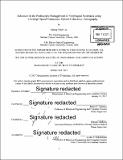Advances in the endoscopic management of esophageal neoplasia using ultrahigh speed endoscopic optical coherence tomography
Author(s)
Lee, Hsiang-Chieh, Ph. D. Massachusetts Institute of Technology
DownloadFull printable version (18.72Mb)
Other Contributors
Massachusetts Institute of Technology. Department of Electrical Engineering and Computer Science.
Advisor
James G. Fujimoto and Hiroshi Mashimo.
Terms of use
Metadata
Show full item recordAbstract
Esophageal cancer is one of the most lethal malignancies, with a five-year survival rate of only 16.7%. Barrett's esophagus (BE) is a premalignant condition with increased risk of developing into esophageal adenocarcinoma, the most common type of esophageal cancer in the West. In current BE surveillance protocol, random biopsies are used to diagnose and detect dysplasia in BE, which is time-consuming and suffers from sampling error. Endoscopic optical coherence tomography (OCT) is a unique imaging technique that can provide micrometer scale, two- and three-dimensional imaging of esophageal tissue without requiring exogenous contrast agents. Although various studies have investigated the feasibility of endoscopic OCT in the human GI tract, the diagnostic accuracy of endoscopic OCT in the detection of dysplasia in BE was still suboptimal. Most previous endoscopic OCT studies were limited to investigating the changes in tissue architecture but not microvasculature, due to hardware limitations of the OCT system and optical scanning instability of the imaging catheters. Alteration of microvasculature has been demonstrated as a critical marker of the neoplastic progression of dysplasia in BE. Although OCT has been demonstrated to provide vascular contrast with OCT angiography (OCTA) in ophthalmology, the translation of OCTA to endoscopic applications has been challenging. The aims of this thesis are: 1) Development of distally actuated imaging devices including a micromotor balloon catheter allowing wide field OCTA imaging and a hollow shaft micromotor catheter enabling unobstructed endoscopic OCT imaging in the gastrointestinal tract. 2) A clinical feasibility study investigating the association of OCTA microvascular features with the detection of dysplasia in patients with BE. 3) Laboratory studies using OCT to monitor radiofrequency ablation (RFA) dynamics with concurrent OCT imaging in ex vivo swine specimens. The scope of this thesis includes the design and development of novel imaging devices, laboratory imaging studies with both ex vivo and in vivo animal models, and a collaborative clinical imaging study with patients. The ultimate goal of this thesis work is to facilitate the implementation of endoscopic OCT and OCTA techniques in the endoscopic management of BE.
Description
Thesis: Ph. D., Massachusetts Institute of Technology, Department of Electrical Engineering and Computer Science, 2017. Cataloged from PDF version of thesis. Includes bibliographical references (pages 148-163).
Date issued
2017Department
Massachusetts Institute of Technology. Department of Electrical Engineering and Computer SciencePublisher
Massachusetts Institute of Technology
Keywords
Electrical Engineering and Computer Science.